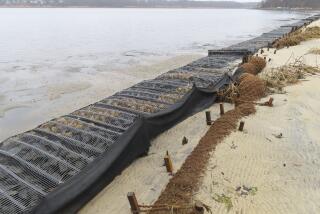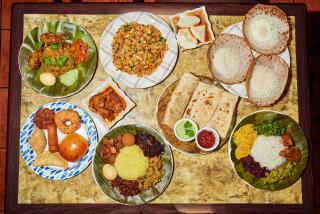Southern India’s Kerala Is the Land of Coconuts
TRIVANDRUM, India — If your search for an earthly paradise has been less than fruitful, try following history’s Phoenician, Greek and Roman galleys, Arab dhows and even Chinese junks to the palm-fringed bays of this thin coastal stretch of tropical greenery on the Indian Ocean.
Trivandrum is the capital of the Indian state of Kerala, meaning “land of coconuts” in the region’s Malayalam language. No name could be more fitting.
Jammed between the sea and coastal mountains, Kerala is subject to the monsoon rains that flood the land and the rice paddies on the subcontinent’s southern tip. Long growing seasons yield a coconut crop every 40 days, with each tree producing 20 to 30 coconuts per harvest. Natives of Kerala, most of whom seem to have at least four or five trees on their small plots of land, claim they are “the trees of heaven.” They use the coconuts themselves for food, coco water and “heady toddy” for drinking; the leaves for mats and roofs, the oil for cooking and the fiber for a thriving rope industry.
Almost every country has its hidden garden, usually a beautiful but unknown region that takes a back seat to more publicized and popular places. Kerala is India’s hidden garden.
Getting here: Fly British Airways nonstop to London, then to Bombay. Lufthansa and Air France will get you here with a home-country stop, Pan Am with stops in New York City and Frankfurt. Take Air India from Bombay to Trivandrum.
How long/how much? Three or four days will give you a feel for the place and time to enjoy its beaches. Lodging and dining costs are moderate to inexpensive.
A few fast facts: India’s rupee recently sold for 15.9 to the dollar, about .063 cents each. November through April is the best period for a visit, with December having the most balmy weather and summers ranging from hot and humid to torrid with monsoons. Sea breezes offer a measure of relief. You must take a driver with your rental car anywhere in India; it costs about $10 to $12 per half-day.
Getting settled in: The Ashok Beach Resort (Kovalam Beach; $60 double) draws many visitors for its air conditioning, pool and location on Kovalam Beach. We suspect, however, that most stay there only because it’s Trivandrum’s best-known hotel.
It’s comfortable enough and the dining room food is good, but we found service somewhere between indifferent and downright indolent.
Rockholm (Light House Road; $20 double) sits on a rocky promontory about 100 yards from the lighthouse, with waves practically washing under the dining terrace. Most of Rockholm’s 16 simple but neat rooms face the ocean, and palm trees surround the place. It has a feeling of an old family home, with guests immediately accepted into the group.
Palmanova (Light House Road; $16 double) is new and also on Kovalam Beach. The style is contemporary Indian, with pleasant bedrooms containing wicker furniture, and coconut-fiber rugs on the floors. It also offers a separate two-bedroom cottage that goes for $32, also sitting in a coconut grove.
The Surya Samudra Beach Resort (Pulinkudi Village; $38-$47 double) is a real find, a small complex of cottages set in a grove of papaya, mango and coconut trees along the beach.
Surya Samudra, named for the gods of the sun and sea, is the inspiration of a German university professor and antiques collector who has gathered native furniture, artifacts and Kerala fabrics for the cottages.
Guests stay in the privacy of their airy huts, which seem taken from a tropical isle movie set, and gather in the main building for meals.
Regional food and drink: Coconut-flavored dishes rank right behind seafood as a staple of the Kerala table, sometimes combined as in meen kootan, a fish cooked in coconut gratings. Meen malabari is fish, Kerala style, in a delicious spicy sauce.
Rice from Kerala’s fertile paddies is another diet staple, present at every meal and the basis for the appam rice-flour pancake, a local addiction. It’s made with sugar and toddy, the fluid taken from the tops of coconut trees by “toddy tappers.” The toddy acts to ferment the appam dough overnight before frying the next day into lacy-edged pancakes with soft, thick centers.
The baji fresh-vegetable fritters are so good that you just keep eating until they’re all gone or taken away.
Good dining: The Shells (Ashok Beach Resort) has a wonderful view of the curving beach to extend a decor motif of shells: a beautiful chandelier of hundreds of them, picked up in the carpet and draperies design.
There is plenty of fresh seafood, plus a vegetarian menu that is always good in southern India. The Shell’s shrimp cocktail is a little different, having pineapple mixed with the shrimp plus a coconut topping. Try the konju pappaas : shrimp cooked in coconut milk.
Hotel Rockholm’s dining room has a local reputation and attracts non-guests to its tables regularly. In spite of its small size and simplicity, Rockholm has an extensive menu, with 15 soups and plenty of Indian, Chinese and Western dishes. There is also a good range of curries costing about $2, a variety of fish from the Arabian Sea and numerous vegetarian plates.
The dining room at Hotel Palmanova has a menu loaded with Kerala specialties: fish baked in local spices; string hauper, a noodlelike dish made with rice flour, steamed in a clay pot and topped with coconut. To show the versatility of the coconut, there are five desserts, all made with coconut, eggs and sugar.
Between the Palmanova and Ashok you’ll find a stretch of beach with a clutch of dining spots all in a row on the sand, all cheap, all with colorful but incongruous names, very atmospheric and typical of Kerala.
On your own: Apart from beach time there are three musts for any visitor. Start with a visit to the Napier Museum, a magnificent architectural melange of Chinese, Muslim and Dravidian styles. Inside, you’ll find a glorious collection of delicate bronzes, many of the god Shiva, some dating from the 2nd Century.
India is noted for its classic dance, and Kathakali (“story play” in Kerala’s language) is a 400-year-old dance drama of the region. It depicts tales of Indian gods, good and evil, all dressed in various colors with facial makeup to match. Performances in the evening at Hotel Neptune ($12 double) on Kovalam Beach.
The Government of India Tourist Office turns over most of its Trivandrum affairs to its local emissary, Babu Varghese, who works out of his Tourindia travel office (and flower shop) on M.G. Road (telephone 965001). Contact Varghese for information or assistance.
Ask Varghese to arrange a dugout boat ride during early morning along the backwater canals that form a network behind the sea and down the coast of Kerala. You’ll observe life along the shores of these placid waters lined with small villages, coconut palms and morning glory vines.
Fishermen pass by slowly in their primitive boats; village folk pound coconut husks into fiber and then spin it into rope on rickety wheels; young men with their ankles tied together shinny up the coconut palms, utter a screech of warning, and whack the nuts loose with their machetes.
For more information: Call the Government of India Tourist Office at (213) 380-8855, or write to 3550 Wilshire Blvd., Suite 204, Los Angeles 90010, for a brochure on Kerala and Trivandrum, plus a map of India listing its sights by region. Ask for the Kerala package.
More to Read
Sign up for The Wild
We’ll help you find the best places to hike, bike and run, as well as the perfect silent spots for meditation and yoga.
You may occasionally receive promotional content from the Los Angeles Times.






